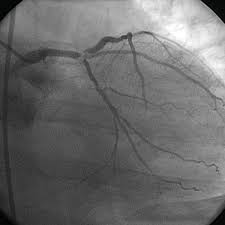Left main coronary artery disease is associated with high morbidity and mortality owing to the large amount of myocardium at risk. European and U.S. guidelines recommend that most patients with left main coronary artery disease undergo coronary-artery bypass grafting (CABG).1,2 Randomized trials have suggested that percutaneous coronary intervention (PCI) with drug-eluting stents might be an acceptable alternative for selected patients with left main coronary disease.3-5 Specifically, in the subgroup of patients with left main coronary disease in the Synergy between PCI with Taxus and Cardiac Surgery (SYNTAX) trial, the rate of a composite of death, stroke, myocardial infarction, or unplanned revascularization at 5 years was similar among patients treated with paclitaxel-eluting stents and those treated with CABG.4 However, the outcomes of PCI were acceptable only in the patients with coronary artery disease of low or intermediate anatomical complexity.4 Because these results represented a subgroup of a subgroup, they were hypothesis generating. Moreover, contemporary metallic drug-eluting stents have a better safety and efficacy profile than do the first-generation stents used in earlier trials.6,7 Surgical techniques and outcomes have also continued to improve, and an evaluation of alternative methods of revascularization for patients with left main coronary artery disease is warranted in a contemporary trial.
METHODS
Trial Design
The design of the Evaluation of XIENCE versus Coronary Artery Bypass Surgery for Effectiveness of Left Main Revascularization (EXCEL) trial has been reported previously.8 In brief, EXCEL was an international, open-label, multicenter randomized trial that compared everolimus-eluting stents with CABG in patients with left main coronary artery disease. Details of the organization of the study are provided in the Supplementary Appendix, which is available with the full text of this article at NEJM.org. The protocol, also available at NEJM.org, was designed by the principal investigators and trial committees, in which interventional cardiologists and cardiac surgeons were represented equally. The trial was approved by the investigational review board or ethics committee at each participating center. The trial was sponsored by Abbott Vascular, which participated in the design of the protocol and in the selection and management of the sites but was not involved in the writing of the drafts of the manuscript or in the management or analysis of the data, although it had the right to a nonbinding review. The principal investigators (the first three authors and the last author) had unrestricted access to the data, were involved in the analysis and interpretation of the data, wrote the first and subsequent drafts of the manuscript, and made the decision to submit the manuscript for publication. The principal investigators vouch for the completeness and accuracy of the data and analyses and for the fidelity of the trial to the protocol. The equipment and drugs used in the study were purchased by the participating hospitals……







